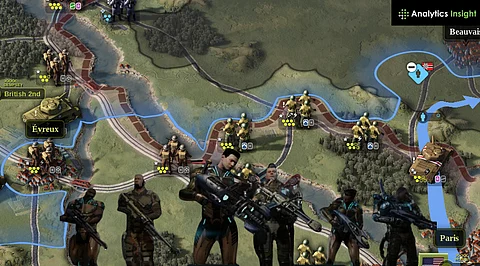

Key Takeaways:
Tactical strategy games offer deep gameplay and immersive worlds, challenging players to think critically and plan ahead.
With the rise of cross-genre experimentation, tactical games are incorporating RPG, roguelike, and card-based elements, offering a fresh experience
Accessibility options and adjustable difficulty levels are becoming increasingly important in tactical games, making them more inclusive for players.
The tactical strategy game genre experienced significant expansion in 2025, introducing new challenges, intricate systems, and immersive worlds. These games test players' logical thinking, patience, and ability to plan ahead through a series of strategic moves. Unlike action games that prioritize fast-paced gameplay, tactical strategy games emphasize careful decision-making and forward planning.
Tactical strategy games prioritize small-scale decision-making and, as such, concentrate on player control of units in grid-based or real-time settings. They will generally involve turn-based gameplay, rich storytelling, and resource or team management. Intellectual difficulty and mixed outcomes, which vary depending on strategic decisions, make them more attractive.
As the player base grows, slower, more strategic play draws them in. Tactical games satisfy these players by providing depth, replayability, and engaging storylines. They also feel natural on mobile and portable platforms, where deep gameplay can be savored in smaller pieces. Streaming services and creators further promoted this genre, making it increasingly popular.
A fresh take on an old franchise, Jagged Alliance 3 combines humor, tactical combat, and character development in a new way. Based in a war-torn nation, the game encourages players to recruit mercenaries and guide them through perilous missions with limited resources.
Following the success of the first, Wargroove 2 improves its turn-based combat and introduces new commanders, skills, and an engaging campaign. An extremely deep combat system offsets its adorable pixel-graphic appearance.
The game combines role-playing game play with tactical combat within the Warhammer universe. Players command a crew aboard a rogue trader vessel, dealing with diplomacy, exploration, and in-depth tactical combat that challenges strategic choice.
Combining card combat with strategic placement, Midnight Suns introduces a new spin on superhero strategy. Drawing upon characters from the Marvel Universe, it combines action and strategy within a storytelling world.
Phantom Brigade combines turn-based strategy with real-time tactics. The player can commandeer a reservoir of mechs that can be tailored and controlled during a battle to retake the player's homeworld. Predictive enemy movement and cinematic realization introduce a new twist to the tactical genre.
Based on the first X-COM games, Xenonauts 2 concentrates on managing global defense and engaging in tactical squad battles. It utilizes realistic combat mechanics and supports risk management.
Nintendo's Fire Emblem franchise continues with Engage, emphasizing mobile character pairings and top-level battlefield strategy. The game continues its tactical heritage with new mechanics and refined graphics.
Miasma Chronicles is a dystopian world set in the future, combining exploration, stealth, and tactical shooting. With its emphasis on setting and story, the game presents an intensely atmospheric experience to tactical fans.
Square Enix developed this one, which seamlessly marries political intrigue with intense battles. Terrain control, classes, and dialogue choices influence the outcomes of the story and battles.
A strange and clever addition, Inkulinati animates medieval manuscript artwork for turn-based combat. Its groundbreaking visual style and offbeat gameplay mechanics provide something new, but grounded in good tactical play.
A quality tactical game should offer significant decisions, varied character skills, well-balanced difficulty, and interesting progression systems. Visual clarity, easy-to-use UI, and replayability are crucial for player investment. Story integration and sound design push the experience to even higher levels.
Cross-genre experimentation is a dominant trend among game makers, who combine RPG, roguelike, and card-based systems with tactical ones. More modding, co-op, and community-sponsored campaign support are changing the way players interact with this genre. Support for accessibility options, adjustable difficulty levels, and cloud gaming is making the audience base more inclusive.
Strategy and tactical games in 2025 are more complex and varied than ever. Fantasy, sci-fi, or historical warfare fare - the gamer has a choice of games that challenge the mind and offer an extended sequence of satisfying gameplay. The mass market appeal of the genre is proof that there exists demand for challenging, strategy-laden gaming experiences.
